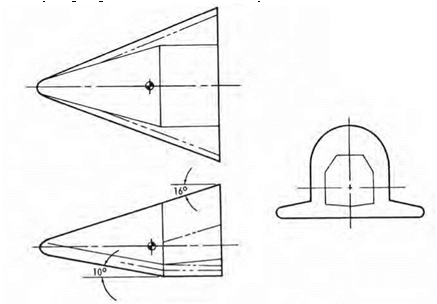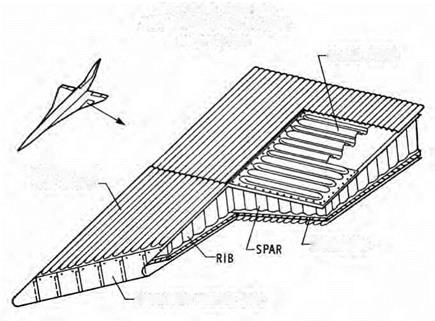Hot Structures: ASSET
Dyna-Soar never flew, for Defense Secretary Robert S. McNamara canceled the program in December 1963. At that time, vehicles were well under construction but still were some 2% years away from first flight.
Still its technology remained available for further development, and thus it fell to a related program, Aerothermodynamic/elastic Structural Systems Environmental Test (ASSET), to take up the hot structures cause and fly with them.[1055]
As early as August 1959, the Flight Dynamics Laboratory at Wright – Patterson Air Force Base launched an in-house study of a small recoverable boost-glide vehicle that was to test hot structures during reentry. From the outset there was strong interest in problems of aerodynamic flutter. This was reflected in the ASSET concept name.
ASSET won approval as a program in January 1961. In April of that year, the firm of McDonnell Aircraft, which was already building Mercury spacecraft, won a contract to develop the ASSET flight vehicles. The Thor, which had been deployed operationally in England, was about to come home because it was no longer needed as a weapon. It became available for use as a launch vehicle.
![]()
 |
|
ASSET took shape as a flat-bottomed wing-body craft that used a low-wing configuration joined to a truncated combined cone-cylinder
body. It had a length of 59 inches and a span of 55 inches. Its bill of materials resembled that of Dyna-Soar, for it used TZM molybdenum to withstand 3,000 °F on the forward lower heat shield, graphite for similar temperatures on leading edges, and zirconia rods for the nose cap, which was rated at 4,000 °F. But ASSET avoided the use of Rene 41, with cobalt and columbium alloys being employed instead.[1056]
ASSET was built in two varieties: the Aerothermodynamic Structural Vehicle (ASV) weighing 1,130 pounds and the Aerothermodynamic Elastic Vehicle (AEV) at 1,225 pounds. The AEVs were to study panel flutter along with the behavior of a trailing-edge flap, which represented an aerodynamic control surface in hypersonic flight. These vehicles did not demand the highest possible flight speeds and therefore flew with single-stage Thors as the booster. But the ASVs were built to study materials and structures in the reentry environment while taking data on temperatures, pressures, and heat fluxes. Such missions demanded higher speeds. These boost-glide craft therefore used the two-stage Thor-Delta launch vehicle, which resembled the Thor-Able that had conducted nose cone tests at intercontinental range in 1958.[1057]
The program eventually conducted six flights:[1058] several of these craft were to be recovered. Following standard practice, their launches were scheduled for the early morning, to give downrange recovery crews the maximum hours of daylight. That did not help ASV-1, the first flight in the program, which sank into the sea. Still, it flew successfully and returned good data. In addition, this flight set a milestone, for it was the first time in aviation history that a lifting reentry spacecraft had traversed the demanding hypersonic reentry corridor from orbit down to the lower atmosphere.[1059]
ASV-2 followed, using the two-stage Thor-Delta, but it failed when the second stage did not ignite. The next one carried ASV-3, with this mission scoring a double achievement. It not only made a good flight downrange, but it was also successfully recovered. It carried a liquid – cooled double-wall test panel from Bell Aircraft along with a molybdenum heat-shield panel from Boeing, home of Dyna-Soar. ASV-3 also had a new nose cap. The standard ASSET type used zirconia dowels, l.5 inches long by 0.5 inches in diameter, which were bonded together with a zirconia cement. The new cap, from International Harvester, had a tungsten base covered with thorium oxide and was reinforced with tungsten.
A company advertisement stated that it withstood reentry so well that it "could have been used again,” and this was true for the craft as a whole. Historian Richard P. Hallion writes that "overall, it was in excellent condition. Water damage. . . caused some problems, but not so serious that McDonnell could not have refurbished and reflown the vehicle.” The Boeing and Bell panels came through reentry without damage, and the importance of physical recovery was emphasized when columbium aft leading edges showed significant deterioration. They were redesigned, with the new versions going into subsequent AEV and ASV spacecraft.[1060]
The next two flights were AEVs, each of which carried a flutter test panel and a test flap. AEV-1 returned only one high-Mach data point, at Mach 11.88, but this sufficed to indicate that its panel was probably too stiff to undergo flutter. Engineers made it thinner and flew a new one on AEV-2, where it returned good data until it failed at Mach 10. The flap experiment also showed value. It had an electric motor that deflected it into the airstream, with potentiometers measuring the force required to move it, and it enabled aerodynamicists to critique their theories. Thus one treatment gave pressures that were in good agreement with observations, whereas another did not.
ASV-4, the final flight, returned "the highest quality data of the ASSET program,” according to the flight-test report. The peak speed of 19,400 ft/sec, Mach 18.4, was the highest in the series and was well above the design speed of 18,000 ft/sec. The long hypersonic glide covered 2,300 nautical miles and prolonged the data return, which presented pressures at 29 locations on the vehicle and temperatures at 39. An onboard system transferred mercury ballast to trim the angle of attack, increasing the lift-to-drag ratio (L/D) from its average of 1.2 to 1.4, and extending the trajectory. The only important problem came when the recovery parachute failed to deploy properly and ripped away, dooming ASV-4 to follow ASV-1 into the depths of the Atlantic.[1061]

 OPTIMUM
OPTIMUM
HOT WING STRUCTURE
NASA CR-1568
SEGMENTED LEADING EDGE
NASA concept for a hypersonic cruise wing structure formed of beaded, corrugated, and tubular structural panels, 1978. NASA.
On the whole, ASSET nevertheless scored a host of successes. It showed that insulated hot structures could be built and flown without producing unpleasant surprises, at speeds up to three-fourths of orbital velocity. It dealt with such practical issues of design as fabrication, fasteners, and coatings. In hypersonic aerodynamics, ASSET contributed to understanding of flutter and of the use of movable control surfaces. The program also developed and successfully used a reaction control system built for a lifting reentry vehicle. Only one flight vehicle was recovered in four attempts, but it complemented the returned data by permitting a close look at a hot structure that had survived its trial by fire.










